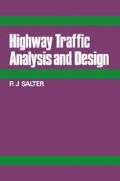Abstract
The capacity of a highway may be described as its ability to accommodate traffic, but the term has been interpreted in many ways by different authorities. Capacity has been defined as the flow which produces a minimum acceptable journey speed and also as the maximum traffic volume for comfortable free-flow conditions. Both these are practical capacities while the Highway Capacity Manual1 defines capacity as the maximum number of vehicles which has reasonable expectation of passing over a given section of a lane or roadway in one or both directions during a given time period under prevailing roadway and traffic conditions.
Preview
Unable to display preview. Download preview PDF.
References
Highway Capacity Manual. Highway Research Board Special Report 87 (1965)
Layout of Roads in Rural Areas. Ministry of Transport, London (1968)
Roads in Urban Areas. Ministry of Transport, London (1968)
Author information
Authors and Affiliations
Copyright information
© 1974 R. J. Salter
About this chapter
Cite this chapter
Salter, R.J. (1974). The capacity of highways between intersections. In: Highway Traffic Analysis and Design. Palgrave, London. https://doi.org/10.1007/978-1-349-02093-5_11
Download citation
DOI: https://doi.org/10.1007/978-1-349-02093-5_11
Publisher Name: Palgrave, London
Print ISBN: 978-1-349-02095-9
Online ISBN: 978-1-349-02093-5
eBook Packages: EngineeringEngineering (R0)

